全国首届小学英语优质课竞赛一等奖教案-In a Fast-food Restaurant
全国小学英语优质课竞赛一等奖教案
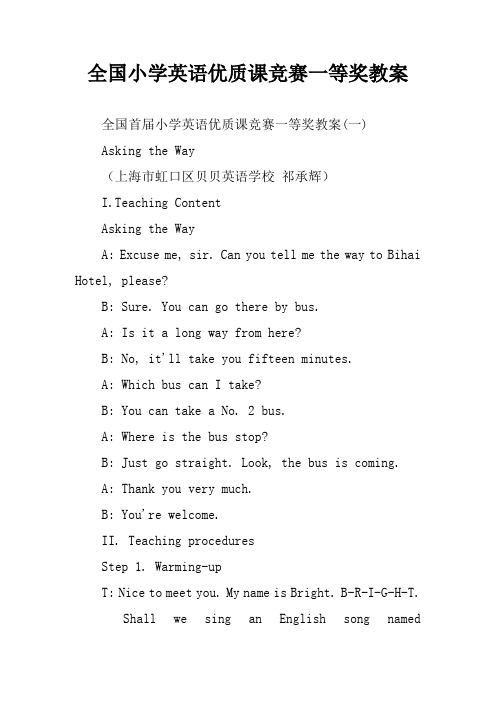
全国小学英语优质课竞赛一等奖教案全国首届小学英语优质课竞赛一等奖教案(一)Asking the Way(上海市虹口区贝贝英语学校祁承辉)I.Teaching ContentAsking the WayA: Excuse me, sir. Can you tell me the way to Bihai Hotel, please?B: Sure. You can go there by bus.A: Is it a long way from here?B: No, it'll take you fifteen minutes.A: Which bus can I take?B: You can take a No. 2 bus.A: Where is the bus stop?B: Just go straight. Look, the bus is coming.A: Thank you very much.B: You're welcome.II. Teaching proceduresStep 1. Warming-upT: Nice to meet you. My name is Bright. B-R-I-G-H-T.Shall we sing an English song named"Bingo", and try to change the' word "Bingo" with my name "Bright"?Step 2. PresentationT: I'm new here, when I arrived at the airport, I heard someone said "对不起"(注①),"早晨好"(注②).I really want to know their meanings in English. Could you help me?S: "对不起" is "Excuse me" and "早晨好" is "Good morning".T: Thanks a lot. And now could you tell me something about your city? I want to travel in this city, but I don't know where I should go.S1: Bai Lian Dong Park.S2: Fisher Girl.S3: Jiuzhou Town.T: Good. But I want to find a hotel now.Please do me a favour. Can you tell me the names of some hotels in this city?S1: XX Hotel.S2: Yindu Hotel.S3: Bihai Hotel.(The teacher takes notes while the students arespeaking.)Step 3. New structures learningT: They all sound very nice. But how can I get there, by bus or by bike?S: By bus.T: And how long will it take me to get there? Maybe fifteen minutes is enough.(The teacher looks at the watch and gives the students a gesture.)1) Draw a stick-figure picture to help the students understand the meaning ofthe sentence:"It'll take someone some time to do something."2) Write the sentence "It'll take you fifteen minutes. " on the blackboard, andhave the students imitate the sentence.3) A guessing game:T: Please look at these pictures and guess "How long will it take me to ...?"T: How long will it take me to have a football match?S1: It'll take you ninety minutes.T: Yes.4) Get the students to listen to the recording of the dialogue, in order tointroduce the new sentence: "Just go straight."5) Use the multi-media to help the students understand the meaning of thesentence "Go straight."6) Write the sentence on the blackboard, and have the students imitate thesentence: "Just go straight."Step 4. Practice1) Ask the students to listen to the dialogue once more, then ask them to repeatafter the tape, first individually and then in pairs.2) Encourage the students to read their dialogue with their deskmates.Step 5. ConsolidationT: You know I'm from Shanghai. Maybe in the future you'll go to Shanghai, soI've prepared some photographs for you.1) Show the photographs of "Nanjing Road", "udong New Area" and "the Bund" to the students.2) Get the students to ask the teachers from Shanghai something they don'tknow, such as directions, transportations in Shanghai.3) Ask some students to introduce their tour plans to Shanghai.注①、注②:因竞赛在珠海举行,授课教师用广东话说“对不起”和“早晨好”。
【免费下载】全国首届小学英语优质课竞赛一等奖教案

全国首届小学英语优质课竞赛一等奖教案全国首届小学英语优质课竞赛一等奖教案(一)Asking the Way(上海市虹口区贝贝英语学校祁承辉)I.Teaching ContentAsking the WayA: Excuse me, sir. Can you tell me the way to Bihai Hotel, please?B: Sure. You can go there by bus.A: Is it a long way from here?B: No, it'll take you fifteen minutes.A: Which bus can I take?B: You can take a No. 2 bus.A: Where is the bus stop?B: Just go straight. Look, the bus is coming.A: Thank you very much.B: You're welcome.II. Teaching proceduresStep 1. Warming-upT: Nice to meet you. My name is Bright. B-R-I-G-H-T.Shall we sing an English song named "Bingo", and try to change the' word "Bingo" with my name "Bright"?Step 2. PresentationT: I'm new here, when I arrived at the airport, I heard someone said "对不起"(注①),"早晨好"(注②).I really want to know their meanings in English. Could you help me?S: "对不起" is "Excuse me" and "早晨好" is "Good morning".T: Thanks a lot. And now could you tell me something about your city? I want to travel in this city, but I don't know where I should go.S1: Bai Lian Dong Park.S2: Fisher Girl.S3: Jiuzhou Town.T: Good. But I want to find a hotel now.Please do me a favour. Can you tell me the names of some hotels in this city?S1: 2000 Hotel.S2: Yindu Hotel.S3: Bihai Hotel.(The teacher takes notes while the students are speaking.)Step 3. New structures learningT: They all sound very nice. But how can I get there, by bus or by bike?S: By bus.T: And how long will it take me to get there? Maybefifteen minutes is enough.(The teacher looks at the watch and gives the students a gesture.)1) Draw a stick-figure picture to help the students understand the meaning of the sentence:"It'll take someone some time to do something."2) Write the sentence "It'll take you fifteen minutes. " on the blackboard, and have the students imitate the sentence.3) A guessing game:T: Please look at these pictures and guess "How long will it take me to ...?"T: How long will it take me to have a football match?S1: It'll take you ninety minutes.T: Yes.4) Get the students to listen to the recording of the dialogue, in order to introduce the new sentence: "Just go straight."5) Use the multi-media to help the students understand the meaning of the sentence "Go straight."6) Write the sentence on the blackboard, and have the students imitate the sentence: "Just go straight."Step 4. Practice1) Ask the students to listen to the dialogue once more, then ask them to repeat after the tape, first individually and then in pairs.2) Encourage the students to read their dialogue with their deskmates.Step 5. ConsolidationT: You know I'm from Shanghai. Maybe in the future you'll go to Shanghai, so I've prepared some photographs for you.1) Show the photographs of "Nanjing Road", "Pudong New Area" and "the Bund" to the students.2) Get the students to ask the teachers from Shanghai something they don't know, such as directions, transportations in Shanghai.3) Ask some students to introduce their tour plans to Shanghai.注①、注②:因竞赛在珠海举行,授课教师用广东话说“对不起”和“早晨好”。
全国首届小学英语优质课竞赛一等奖教案
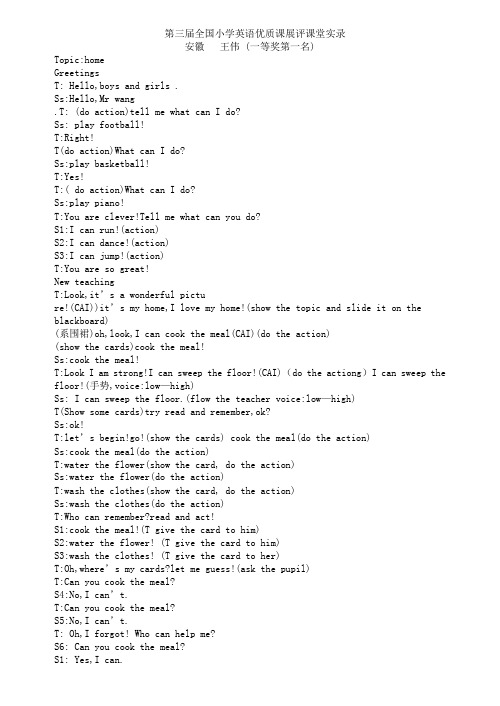
第三届全国小学英语优质课展评课堂实录安徽王伟 (一等奖第一名)Topic:homeGreetingsT: Hello,boys and girls .Ss:Hello,Mr wang.T: (do action)tell me what can I do?Ss: play football!T:Right!T(do action)What can I do?Ss:play basketball!T:Yes!T:( do action)What can I do?Ss:play piano!T:You are clever!Tell me what can you do?S1:I can run!(action)S2:I can dance!(action)S3:I can jump!(action)T:You are so great!New teachingT:Look,it’s a wonderful picture!(CAI))it’s my home,I love my home!(show the topic and slide it on t he blackboard)(系围裙)oh,look,I can cook the meal(CAI)(do the action)(show the cards)cook the meal!Ss:cook the meal!T:Look I am strong!I can sweep the floor!(CAI)(do the actiong)I can sweep the floor!(手势,voice:low—high)Ss: I can sweep the floor.(flow the teacher voice:low—high)T(Show some cards)try read and remember,ok?Ss:ok!T:let’s begin!go!(show the cards) cook the meal(do the action)Ss:cook the meal(do the action)T:water the flower(show the card, do the action)Ss:water the flower(do the action)T:wash the clothes(show the card, do the action)Ss:wash the clothes(do the action)T:Who can remember?read and act!S1:cook the meal!(T give the card to him)S2:water the flower! (T give the card to him)S3:wash the clothes! (T give the card to her)T:Oh,where’s my cards?let me guess!(ask the pupil)T:Can you cook the meal?S4:No,I can’t.T:Can you cook the meal?S5:No,I can’t.T: Oh,I forgot! Who can help me?S7:Can you sweep the floor?S8:No,I can’t.S7:Can you sweep the floor?S2:Yes,I can.S9:Can you wash the clothes?S3:Yes,I can.T:You are so cool!look ,let’s go!(手势,voice low—high)Can you wash the clothes?Ss: Can you wash the clothes?(flow the teacher, 手势,voice low—high)T:who can do it ?(手势) come to front!S10: let’s go!(手势,voice low—high)Can you wash the clothes?Ss: Can you wash the clothes?(flow the teacher, 手势,voice low—high)T:wonderful!You should say:yes!S10:Yes!(do the actin)T:Who else?S11: let’s go!(手势,voice low—high)Can you wash the clothes?Ss: Can you wash the clothes?(flow the teacher, 手势,voice low—high)S11:Yes!T:You have done a good job!Now,I will give a paper to you,listen to the tape ,then answer the question on it,ready?Ss:Yes!T;Go!(tape) Amy:Hello,Sam! Sam:Hello!A:Can you water the flower? S:Yes,I can.A:Can you cook the meal? S:No.I can’t.A:What do your parents do at home?Can your father cook themeal? S:No,he can’t.A:Can your mother cook the meal? S:Of course!Sometimes,my parents wash the clothes,?together.T:Ok,change your ideas by yourgroup.Then answer the question.>T:let’s look the question,together.Can Sam water the flower?Ss:No,he can’t.T:Can Sam cook the meal?Ss:No,he can’t.T:Who can cook the meal?Ss:Sam’s mother can cook the meal.T:You are so clever!Now let’s play a game! Who can come to front?(let the pupil come to the front,give a card tohim,then let him act.)S12:(Do the action)guess!S13:Can you dance?S12:No,I can’t.S14:Can you water the flower?S12:Yes,I can.S14:Yes!(practice play football,brush teath,cook the meal,play basketball in the same way)T:Who can do house work in your home?S15:my motherS16: my motherS17:my fatherS18:me!T:good we should do house work together,let’s make a house work plan,here’s the plan,finsh it by your groupWhat can you do?What can your father do?What can your mother do?Ss:Ask and answer in the group finsh the house work planT:let’s look the house plan of S16’s,let’s ask !Ss: What can you do?S16:I can sweep the floor.Ss: What can your father do?S16:He can wash the clothes.Ss: What can your mother do?S16:She can cook the meal.T:Good plan ,a happy family!let’s look and sing,do the actins together,ok?(CAI) Ss(look and sing do the action)Can you run?Yes,I can.Can you sing? Yes,I can.Can you dance?No,I can’t.T:Ok,are you happy today?Ss:Yes.T:let’s say yes(do action)Ss:Yes!(do action)上海吴绯霞课题: Travel授课过程:(A) Warmer up:(The pupils come to the seat.)T: Hello, where are you from?Ss: I’m from xx Primary School.T: Welcome.(Show a cartoon picture of the teacher on the screen.)T: Can you guess who’s she?Ss: Cindia.T: Yes, it’s m e.(The pupils come to the seat and sit well.)(B)New Teaching.(Teacher plays the music of Beijing Opera.)T: Beijing is a beautiful city. We’ll go to Beijing tomorrow. What will we watch? Ss: We’ll watch Beijing Opera.T: What will we eat?Ss: We’ll eat rock duck.T: Tomorrow it’ll be Wednesday. We’ll go to Xiangshan on Wednesday.What will we do on Thursday?S1: We’ll go to Tian’an men.T: What will you do on Friday?S2: We’ll go to the Great Wall.T: Saturday?S3: We’ll go to the Summer Palace.T: We’ll watch Beijing Opera on Sunday.T say a chant: We’ll go to Beijing. We’ll eat there. We’ll go to the Summer Palace. We’ll have good time there.Ss say the chant again.T: Beijing is a good place. (Then teacher show a VCD: Succession of Beijing’s application for Olympic Games.)(Teacher shows a fan and act as a beautiful girl in Suzhou.)T: Where am I from?Ss: Suzhou.T: Where have you visited in Suzhou? Can you say something?S1: LiuYuan.S2: Shi Zilin.S3: Han Shansi.T: You have some pictures on your desk. You can say where you will go.(The pupils say the sentences in the groups.)T: Where will you go?S1: I’ll go to Liu Yuan.T: What will you see?S1: I’ll see many flowers.T: There are many beautiful places in Suzhou. Have you got friends in other city? Ss: Yes.(Teacher shows a postcard.)T: Look at the postcard. On the postcard what can we write?S1: We are in Suzhou.(Teacher writes the sentence on the card.)T: Suzhou is a beautiful city. There are lots of trees. I love this city. (Ss write the postcards in groups and teacher plays the tape of the music.) Then each group give a report.(Teacher shows a picture of Hanshan Temple.)T: What’s this?Ss: Hanshan Temple.T: I love the place. Do you know why? (Play the tape of music)T: Do you want to Hanshan Temple? Look at the map of Suzhou. Hanshan Temple is here. (Show the map of Suzhou and Hanshan Temple.)T: How can we go there? Walk there? By foot? No.S1: We’llS2: We’ll go there by bike.T: And?S3: We’ll go there by motorcycle.S4: We’ll go the re by car.T: Look, this is a plan for visiting Suzhou. Let’s finish this form together. (Show a big form on the blackboard.)A Plan For Visiting Suzhouwherewhenhowphotos card(Teacher and the pupils finish the form together. And the pupils come to the front and stick the photos and cards in the form. Then pupils give a report.)T: Welcome to Suzhou四川何霞课题:FestivalsⅠ.Warming up:T: Good morning, boys and girls.Ss: Good morning, teacher.Ⅱ.New Teaching:T: What do you know about some festivals?S1: Children’s Day.T: Good.S2: Teacher’s Day.T: Wonderful.T: What is the most important festivals in China?S3: Spring Festival.T: What is the most important festivals in USA?S3: Christmas.T: Let’s say something about Christmas.S4: Snow.S5: Tree.S6: Presents.S7: Food.(板书)T: I have a student. His English is poor. His name is Jason. Now there is a letter. Let’s read it and help him.(教师领读,学生跟读。
小学英语教学精品之一:全国首届小学英语优质课竞赛一等奖教案(一)

小学英语教学精品之一:全国首届小学英语优质课竞赛一等奖教案(一))随着全球化的加速,英语的重要性也日益凸显。
小学英语教学的质量和成效直接关系到后续英语学习的效果,因此,如何提高英语教学的质量和效果,已成为广大教学工作者共同关注的焦点。
而全国首届小学英语优质课竞赛则是为了促进小学英语教学质量的提升而举办的。
在这场竞赛中,一等奖教案(一)因其创新性、实用性以及教学效果受到了广泛好评,并成为了小学英语教学的精品案例之一。
教学背景这节课是一节关于“食物”的话题课。
学生已经学过一些食物的单词,但是对于它们的用法和表达方式还比较陌生。
教学目标1.学生能够听懂并掌握关于食物的基本表达方式。
2.学生能够运用所学的单词和句型,表述自己对食物的喜好和不喜好。
3.学生能够运用所学的单词和句型,进行食物相互传递和讨论。
教学重点1.掌握“Do you like…”和“It’s…”的用法。
2.学会表述自己对食物的喜好和不喜好。
3.学会使用个体主义和集体主义的表达方式。
教学难点如何使学生在实际的交际中运用所学的语言知识。
教学过程一、情境导入教师播放一些食物的图片,询问学生对它们的了解程度,并引导学生回忆所学过的食物单词。
二、语言引入教师通过PPT展示一张“Do you like…”的图片,引导学生掌握这个常用的句型。
随后,教师展示另一张包含各种食物的图片,用这两个句型引导学生表述自己对不同食物的喜欢程度。
三、语言运用1.个体主义表达方法:教师将学生分组,每组讨论自己最喜欢的食物,并用“Do you like…”和“It’s…”的句型表达自己的观点。
随后,教师将不同组的学生叫到前面,就他们各自最喜欢的食物进行讨论。
2.集体主义表达方法:教师告诉学生,今天中午,班级将一起去食堂吃饭,但是我们应该如何订餐呢?教师提供几种选择,要求学生借助页面上提供的句型以及所学的单词和句型进行讨论,并提出他们自己的建议和意见。
教师将学生的讨论结果行汇总,使得学生理解到集体主义的表达方法。
全国小学英语优质课竞赛一等奖教案

全国小学英语优质课竞赛一等奖教案全国首届小学英语优质课竞赛一等奖教案(一)Asking the Way(上海市虹口区贝贝英语学校祁承辉)I.Teaching ContentAsking the WayA: Excuse me, sir. Can you tell me the way to Bihai Hotel, please?B: Sure. You can go there by bus.A: Is it a long way from here?B: No, it'll take you fifteen minutes.A: Which bus can I take?B: You can take a No. 2 bus.A: Where is the bus stop?B: Just go straight. Look, the bus is coming.A: Thank you very much.B: You're welcome.II. Teaching proceduresStep 1. Warming-upT: Nice to meet you. My name is Bright. B-R-I-G-H-T.Shall we sing an English song named"Bingo", and try to change the' word "Bingo" with my name "Bright"?Step 2. PresentationT: I'm new here, when I arrived at the airport, I heard someone said "对不起"(注①),"早晨好"(注②).I really want to know their meanings in English. Could you help me?S: "对不起" is "Excuse me" and "早晨好" is "Good morning".T: Thanks a lot. And now could you tell me something about your city? I want to travel in this city, but I don't know where I should go.S1: Bai Lian Dong Park.S2: Fisher Girl.S3: Jiuzhou Town.T: Good. But I want to find a hotel now.Please do me a favour. Can you tell me the names of some hotels in this city?S1: XX Hotel.S2: Yindu Hotel.S3: Bihai Hotel.(The teacher takes notes while the students arespeaking.)Step 3. New structures learningT: They all sound very nice. But how can I get there, by bus or by bike?S: By bus.T: And how long will it take me to get there? Maybe fifteen minutes is enough.(The teacher looks at the watch and gives the students a gesture.)1) Draw a stick-figure picture to help the students understand the meaning ofthe sentence:"It'll take someone some time to do something."2) Write the sentence "It'll take you fifteen minutes. " on the blackboard, andhave the students imitate the sentence.3) A guessing game:T: Please look at these pictures and guess "How long will it take me to ...?"T: How long will it take me to have a football match?S1: It'll take you ninety minutes.T: Yes.4) Get the students to listen to the recording of the dialogue, in order tointroduce the new sentence: "Just go straight."5) Use the multi-media to help the students understand the meaning of thesentence "Go straight."6) Write the sentence on the blackboard, and have the students imitate thesentence: "Just go straight."Step 4. Practice1) Ask the students to listen to the dialogue once more, then ask them to repeatafter the tape, first individually and then in pairs.2) Encourage the students to read their dialogue with their deskmates.Step 5. ConsolidationT: You know I'm from Shanghai. Maybe in the future you'll go to Shanghai, soI've prepared some photographs for you.1) Show the photographs of "Nanjing Road", "udong New Area" and "the Bund" to the students.2) Get the students to ask the teachers from Shanghai something they don'tknow, such as directions, transportations in Shanghai.3) Ask some students to introduce their tour plans to Shanghai.注①、注②:因竞赛在珠海举行,授课教师用广东话说“对不起”和“早晨好”。
竞赛一等奖小学英语教案解析:全国首届小学英语优质课竞赛教案(一)

竞赛一等奖小学英语教案解析:全国首届小学英语优质课竞赛教案(一))随着我国经济的发展和国际交往的日益频繁,英语已成为重要的外语学习之一。
小学英语教育是英语学习的起点,也是培养学生英语基本能力的关键阶段。
如何开展一堂优质的小学英语课程是当前小学英语教育面临的问题之一。
为了提升小学英语教学水平,全国首届小学英语优质课竞赛应运而生。
本文将重点解析竞赛一等奖小学英语教案,探讨如何开展优质小学英语课程教学。
一、教学目标针对小学低年级学生英语学习的特点,本堂课主要围绕听、说、读、学习策略四方面列出具体的教学目标。
听1.能够听懂并能正确回答有关食物及饮料的问题。
2.能独立完成听力材料中有关食物的配对和答题。
说1.能够就自己喜欢的食物和饮料进行表达并能描述两种不同食物的不同以及自己更中意的那种食物。
2.能够用英语权衡选择食物和饮料。
读1.能够读懂并朗读材料中有关食物及饮料的信息。
2.能够独立查询学习材料中有关食物及饮料的词汇。
学习策略1.学生能够合作学习,并能用英语交流;2.学生能够运用字典及其他学习工具查询学习内容。
二、教学内容本堂课程的核心内容包括“食物”和“饮料”两个单元。
在听力、口语、阅读、学习策略等方面提供丰富的培养素材,确保学生能全面发展其英语语言能力。
听力通过采用多种听力材料,如英语歌曲、短语、彩色图片来让学生在听的过程中感受到英语的美妙之处。
让学生通过听力练习能学会英语口语及语音,并且能正确理解听力材料的内容。
本堂课的听力部分主要涉及食物的名称、颜色、味道等关键信息的学习。
口语本堂课程通过教师和学生之间的互动,让学生在积极、开放和轻松的氛围下学习英语口语。
通过教师即兴提问和学生组织对话等交互方式开展口语训练。
让学生在听力练习中逐渐习得单词、短语和句子,并能够流利表达自己的想法。
阅读通过有趣的故事和图片帮助学生对英语语言的理解。
通过阅读外文书籍及其他英语文本,学生能够更好的了解英语国家的文化及其他方面。
首届小学英语优质课竞赛一等奖获奖教案分享:教案二
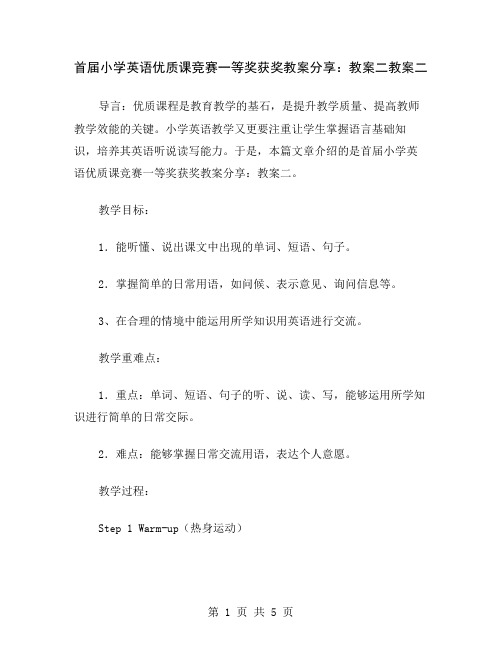
首届小学英语优质课竞赛一等奖获奖教案分享:教案二教案二导言:优质课程是教育教学的基石,是提升教学质量、提高教师教学效能的关键。
小学英语教学又更要注重让学生掌握语言基础知识,培养其英语听说读写能力。
于是,本篇文章介绍的是首届小学英语优质课竞赛一等奖获奖教案分享:教案二。
教学目标:1.能听懂、说出课文中出现的单词、短语、句子。
2.掌握简单的日常用语,如问候、表示意见、询问信息等。
3、在合理的情境中能运用所学知识用英语进行交流。
教学重难点:1.重点:单词、短语、句子的听、说、读、写,能够运用所学知识进行简单的日常交际。
2.难点:能够掌握日常交流用语,表达个人意愿。
教学过程:Step 1 Warm-up(热身运动)Greet the students according to the time of day: Good morning, Good afternoon or Good evening。
Step 2 Introduction(引入)Show the students some pictures about school and ask them:1.Where is this?2.What can you see in the pictures?3.Who is this in the picture?Answer:1.This is school.2.I can see classroom, teacher, student, computer andso on.3.This is my teacher.Step 3 Vocabulary(词汇)1.Look, listen and repeat.(看、听、重复)Ask the students to look at the pictures and listen to the teacher say the words. Then, let them repeat after the teacher.2.Match and say.(连线、说)Ask the students to match the pictures to the words, then say the words.Step 4 Grammar(语法)1.Listen and circle.(听、圈出)Ask the students to listen to the sentence and circle the correct word.2.Look and say.(看、说)Ask the students to look at the pictures and use the sentences to describe the pictures.Step 5 Practice(练习)1.Pair work.(分组练习)Ask the students to work in pairs and role-play the conversation.2.Group work.(小组讨论)Ask the students to work in groups of three or four and discuss the questions.Step 6 Production(评价)1.Show time.(表演)Ask the students to perform the dialogue in front of the class.2.Homework.(家庭作业)Ask the students to write a short composition about their school.教学亮点:1.布置操作性强:热身运动简单易行,相信任何没有学习障碍的小学生都稳稳能接住;2.引入方式具有很强的钩子,用图片将新单词与实物联系在一起,让学生的思维立刻开始进入英语状态,培养起他们的学习兴趣和主动学习的能力;3.教案中的练习也分层次,分类型,既有听说读写,也有小组活动和个人作业,全方位地培养他们在英语学习中的多元技能;4.每个环节操作性很强,能量明显地压低难度,但它们互为依据,相互联系,既能让学生循序渐进地掌握英语知识,也能让老师抓住他们学习的主观状态,及时对学生进行这样或那样的指导。
教学评估二:全国首届小学英语课竞赛一等奖教案

教学评估二:全国首届小学英语优质课竞赛一等奖教案本次全国首届小学英语优质课竞赛一等奖教案的主题是“游戏中学英语”,该教案由一位来自广东省深圳市的小学英语教师所撰写。
本文将为大家详细介绍这一教案的内容、实施方法与特色。
一、教案内容简介本教案的教学目标是帮助小学生通过游戏的方式学习英语,提高学生听、说、读、写的综合能力,提高他们对英语的兴趣,同时也让学生在游戏切磋中增进班级之间的友谊。
教案共有四个环节:第一环节是“学语音”,利用唱歌游戏的形式让学生能够快速地掌握英语的基本发音规律;第二环节是“做选择题”,针对英语的语法和语义规则,让学生在自主学习的同时感受到游戏的乐趣;第三环节是“模仿剧”,通过模仿短小精悍的角色语句或抵制游戏来提高学生的口头表达能力;第四环节是“口语交际”,让学生利用所学知识编排对话,从而提高他们的日常口语能力。
除了以上四个环节外,本教案还包括学生评价、教师评价以及家长评价三个环节,以此让教师和家长能够更好地了解学生的学习情况,及时发现和解决学生的问题。
二、实施方法本教案的实施方法可以分为以下几个步骤:第一步,教师首先要详细了解教案的内容,掌握每个环节的实施方法和注意事项,确保教学过程中的顺畅。
第二步,通过讲解和示范,让学生理解游戏的规则和要求,并鼓励学生积极参与,享受游戏的过程和提高英语的乐趣。
第三步,教师要在游戏过程中及时指导学生,帮助他们解决遇到的问题,并及时做好学生评价、教师评价和家长评价的工作,以此不断改进教学质量。
三、教案特色本教案具有以下特色:本教案充分结合学生的爱好和兴趣,让学习英语变得更加轻松、有趣。
本教案突破传统教学模式,采用了游戏的方式,把教育与娱乐完美结合,让学生在娱乐中合理运用英语。
本教案注重口语交际和语音训练,强化日常口语表达能力,同时也让学生能够在游戏过程中自我完善。
本教案通过学生评价、教师评价和家长评价等环节,提升了教学质量,让教学效果变得更加显著和可持续。
教学设计二:全国首届小学英语课竞赛一等奖教案

教学设计二:全国首届小学英语优质课竞赛一等奖教案作为小学英语教师,我们不仅要有丰富的英语教学知识和技巧,更要有创新的教学设计,能够激发学生的学习兴趣和积极性。
在这方面,教学设计的高质量是至关重要的。
今天,我要跟大家分享一下我所设计的教案,在全国首届小学英语优质课竞赛中获得了一等奖的优秀教案。
一、教育教学原则这是一节以听、说、读、写相结合的英语课。
我追求灵活多样,启发学生思维、培养多方面能力的教学。
在教学中,我始终遵循“兴趣为先导,知识为主线,能力为目标”的教育教学原则,以让学生尽可能地参与来,运用语言交际,完成各项任务,提高自身能力水平。
二、教学目标1、让学生能够听懂和会说颜色的英语单词以及一些常用的英语词汇。
2、让学生能够通过听、说、读、写综合运用语言,培养其多方面发展。
3、让学生通过合作学习,提高合作能力及友好意识,建立团队合作观念。
三、教学重点难点1、颜色的英语单词。
2、一些常用的英语词汇。
3、阅读口语交际。
四、教学步骤Step 1:导入设身处地的语言教学法,带领学生用英语介绍自己的外貌特点。
Step 2:新课呈现--颜色播放有关颜色的视频,介绍英语中常用的颜色单词,并进行听、说、读练习。
Step 3:热身活动--动手实践通过进行颜色拼图游戏,调动学生的思维及动手操作能力。
Step 4:综合运用--小组合作组织学生进行颜色匹配、图画配对等小组活动,提高合作能力及友好意识,建立团队合作观念。
Step 5:语言运用引导学生通过图片和语言对话,加强口语表达能力。
在引导学生进行口语表达时,老师应该根据学生的口音特点,进行科学指导。
五、教学效果在本次小学英语课教学设计中,我通过诸如颜色拼图、小组合作等多种教学方式,从而将颜色的英语单词及一些常用英语词汇教授给了学生,培养学生的语言听、说能力,促进英语应用,提高学生的英语初步思维和表达能力,为其语言学习奠定坚实的基础。
同时,在课堂的合作、交流互动中,学生们也体验到了高尚情操的感召力,培养了核心素养和创造力。
全国首届小学英语优质课竞赛一等奖教案(三)
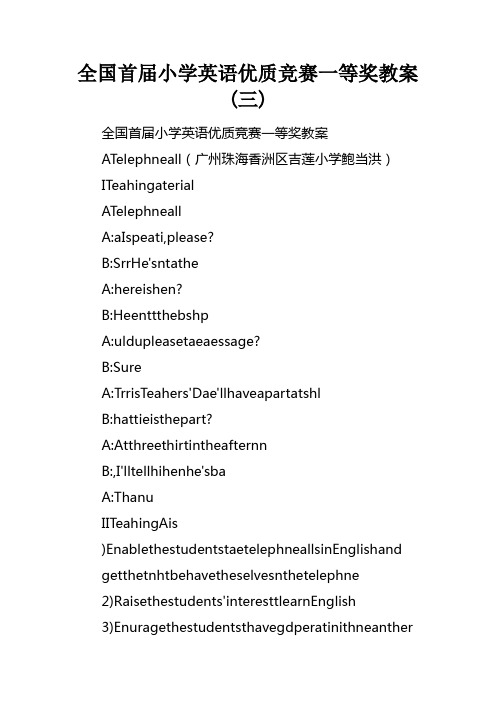
全国首届小学英语优质竞赛一等奖教案(三)全国首届小学英语优质竞赛一等奖教案ATelephneall(广州珠海香洲区吉莲小学鲍当洪)ITeahingaterialATelephneallA:aIspeati,please?B:SrrHe'sntatheA:hereishen?B:HeenttthebshpA:uldupleasetaeaessage?B:SureA:TrrisTeahers'Dae'llhaveapartatshlB:hattieisthepart?A:AtthreethirtintheafternnB:,I'lltellhihenhe'sbaA:ThanuIITeahingAis)EnablethestudentstaetelephneallsinEnglishandgetthetnhtbehavetheselvesnthetelephne2)Raisethestudents'interesttlearnEnglish3)EnuragethestudentsthavegdperatinithneantherIIITeahingntents)Patterns:aIspeat?uldupleasetaeaessage?2)Vabular:essage,part,taeaessageIVteahingAidsFurttelephnes,aD-R,atSantalausVTeahingpreduresStep1aring-upExeriseSingthesng"Greetings"Step2PresentatinandPratie)Asthestudentstlatthesreenandlistentthetalbeteen theteaherandthepersninthesreen2)Afterthetal,theteahertellsthestudentshtaeatelephne allinEnglishritethepattern"aIspeat?"ntheblabardandteahth ehtuseitnthephne3)Usingthefurttelephnes,asthestudentstaetelephneallsinpairsiththefllingpatterns:----aIspeat?----SpeaingThsestudentshdnthavettelephnesanusetheirpenil-bxesinstead,rtheanputtheirfingersttheirearsasasigntaephn ealls4)Asnestudenthis/hernaeandhis/herhetelephnenuber, usingthefllingsentenes:ulduplease'telleurnae?uldupleasetelleurhetelephnenuber?)aeatelephnealltastudentandgetthestudentstlearn thefllingshrtdialgue:T:HellIsthat8614761?S:esT:aIspeatXiaLng?S:Srr,heisntintheffieT:uldupleasetaeaessageandashitetshlthisafternn?S:SureT:Thanu6)AsthestudentstaeallsingrupsThenassepairstatuttseeifthenhtusethepatternsbel: aIspeat,?uldupleasetaeaessage?7)Asthestudentstlatthesreenandlistentthedialgue"ATel ephneall"iththefllingquestinsinind:hatistheessageabut?hattieisthepart?Thenasthestudentssequestinsifthehaveunderstdthedialgue8)Asthestudentstlatthedialguenthesreenandlistentitag ain9)Theteahertellsthestudentstheeaningftherd"trr"iththehelpfaalendarandthefllingsentenes:e'llhaveapartatshlI'lltellhihenhe'sba0)Asthestudentstreadthenerdandthesentenesntheblab ard1)Asthestudentstretellthedialgueintheirnrdsinpairs2)Plathegae"ThringSantalaus"tseeifthestudentsansath esentenesellTheteaherthrsthetSantalaustastudenthenthestudentat hestheSantalaus,hersheustsanefthesentenesntheblabard, andthenthrstheSantalaustantherstudent3)AsthestudentstatutthedialgueinrlesStep3)ShthestudentsthreepituresnthesreenAsthetaetelephneallsingrupsbasednthepiturethehavehsenPiturene:uanttinviteTtplaftbaUithu,butThasn'tgtatelep hneatheuasRsettaeaessagetTPitureT:issuisilluanttpaavisittherithaButaisntateHissiste rpisupthephnePitureThree:uillhldabirthdapartnSundauphnetLiltinviteherturpart,butsheisn'tatheHduspeatherther,hisatheatthattie?2)Assepairstatuttheirtelephnealls3)Asthestudentstaephneallsttheteahersharesittingarun dthedassrTheteahertellsthestudents:"ThereillbeapartnNeear'sDa eillinviteseteahersteturpartritethenaesandthetelephnenubersfseteahersandae telephneallstthe"Step4SuarTellthestudentstheafaingaphneallintheirdaillifeStepHerAsthestudentstaephneallsttheirfriendsandtellthetheirs hllifeafterlassStep6:EndingSingthesng"Happeeend"专家点评鲍当洪教师执教的ATelephneall是一节真实、自然、生动、有趣的小学英语。
课件制作教案二:全国首届小学英语课竞赛一等奖教案

近年来,随着中国国力的逐渐增强,教育事业也越来越受到政府和社会各界的关注,其中包括小学英语教育也备受各界关注,因此,全国首届小学英语优质课竞赛一等奖教案备受瞩目。
今天,我们就来一同探讨一下这份教案。
一、竞赛简介全国首届小学英语优质课竞赛是由国家语言文字工作委员会主办、全国英语教育研究会等协办的全国性小学英语课堂教学竞赛。
本次竞赛旨在推动小学英语教育的规范化、标准化和现代化,提高小学英语教学水平和质量,树立小学英语教学的典范,为全国小学英语教学改革提供智力支持和比较研究。
二、教案介绍本次竞赛中获得一等奖的教案是一份四年级上册英语教案,整份教案由英语教师唐欣借鉴国内外先进教育理念和方法、结合自身教学经验精心编写而成,获得了专家评审团的高度赞扬和认可。
本份教案的教学内容主要涵盖了“Unit 2 I’m from England”以及“Unit 4 Where’s the post office?”这两个单元的教学内容,整份教案精致、详细,囊括了教学目标、教学重点、教学难点、教学重要环节、教学方法等方面,在短短一堂课的时间内对学生的英语口语和听力综合能力的提高起到了很好的促进作用。
在教案的教学设计上,唐欣老师在课前主动了解学生的生活背景和学习情况,针对学生的特点,选择了多种教学手段,比如说配合PPT展示课件,结合生动有趣的图片和视频,以生动形象的方式讲解了地理文化知识;利用问题抛出者的角色,引导学生交流思考,提升学生的口语表达和交流能力。
教学过程中,唐欣老师还很好地结合了学生的兴趣特点,将教学内容与学生感兴趣的电影片段有机结合,为学生打造了一个轻松愉快且充满互动性的学习氛围,让学生们在快乐中学习。
三、教案启示通过对唐欣老师的教案进行深入分析,我们能够发现到其成功的原因在于多方面的综合利用:教学准备充分,教学方式多样,教育手段多元化,互动性高,从而激发了学生的学习兴趣,提高学生口语和听力综合能力,让学生在愉快的氛围中快乐学习。
【学习实践】全国首届小学英语优质课竞赛一等奖教案 (二)

全国首届小学英语优质课竞赛一等奖教案 (二)课件www.5y 全国首届小学英语优质课竞赛一等奖教案Shopping(湖南省长沙市育英学校欧阳丹熙)一、教学内容ShoppingA:Hello!canIhelpyou?B:yes,Iwantasweaterformydaughter,please.A:Howaboutthisone?B:oh,good.Thesizeisok.c:mum,Idon'tlikethecolour.A:Doyoulikethispurpleone?c:cool!That'smyfavouritecolour.B:Howmuchisit?A:Sixty-eightyuan.B:Here'sthemoney.A:Thanks.size尺寸;大小purple紫色的cool棒的二、教学目的与要求.能听懂、会说本篇对话;2.能运用会话中的句型进行扩展性的情景会话;3.能听懂、会说新单词:purple,size,cool。
三、教学重点能运用所学句型进行扩展性的情景会话。
四、教学手段运用多媒体辅助教学。
五、教具准备一件毛衣,各种文具、食品、服装、玩具和水果等六、教学步骤Step1.GreetingsT:Goodmorning,boysandgirls.gladtomeetyou.Step2.PresentationLead-inT:youknow,I'mnewhere.IthoughtitwouldbehotinZhuha.Bu ttodayitiscold.I'mjustinablouse.NowI'mfeelingalittlecold.SoIwanttogoshoppingandbuysomewarmclothes.Playaguessinggame(:显示屏上出现一些碎片,碎片慢慢扩大,变成一件毛衣)T:whatamIgoingtobuy?whatdoIwant?justguessandsay:"yo uwant..."T=theteacherc=thecomputerSs=thestudentsc:canIhelpyo u?T:Iwantasweater,sir.c:Howaboutthisone?(:售货员拿出一件很大的毛衣。
InaFast-foodRestaurant(优质课竞赛一等奖教案)

InaFast-foodRestaurant(优质课竞赛一等奖教案)I.教学内容InaFast-foodRestaurantaiter:Hello,canIhelpyou?u:yes.hatouldyoulie,Dic?Dic:I’dlieahaburger.u:e,too.aiter:ouldyouliesoethingtodrin?u:oh,yes.Toglassesoforangejuice,please.Dic:u,canIhaveanice-crea?u:Sure.Tohaburgers,toglassesoforangejuiceandanice-c rea.aiter:o.Hereyouare.38yuan,please.u:Heretheoney.aiter:Thans.生词:fast-food/resaurant/haburger句型:hatouldyoulie?ouldyouliesoethingtoeat/drin?II、教学目标:能听、读、说fist-food/restaurant/haburger,并了解其含义;.能灵活运用重点句型,并清楚其运用的场合和语气;hatouldyoulie?ouldyouliesoethingtoeat/drin?.能模仿本文对话,并能在一定的语境中运用所学语言进行交际;.培养学生的注意力和观察力,激发学生积极思维,挖掘学生运用语言的创造能力。
III、教学重难点:.重难点句型:hatouldyoulie?I’dlie...ouldyouliesoethingtoeat/drin?…,please..掌握有关食物名称的词汇。
III、教具准备:食物图片:ice-crea,haburger,cae,bread,juice,il,ater,hot-dog,Frenhfries等。
食物和饮料:haburger,cae,bread,il,orangejuice,cola等。
全国首届小学英语优质课竞赛一等奖教案
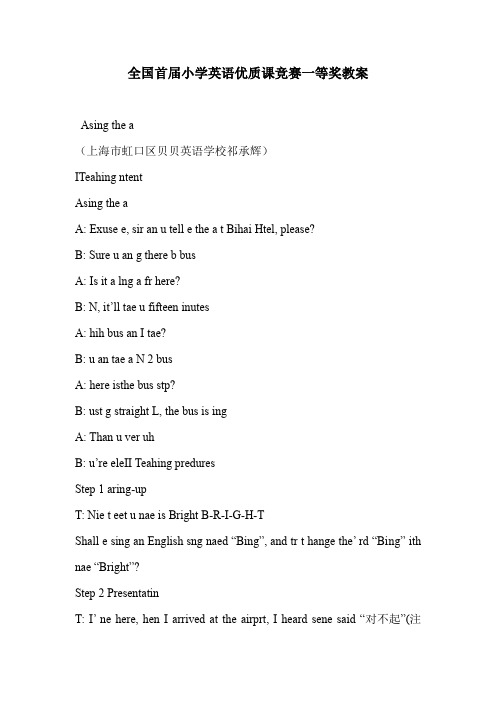
全国首届小学英语优质课竞赛一等奖教案Asing the a(上海市虹口区贝贝英语学校祁承辉)ITeahing ntentAsing the aA: Exuse e, sir an u tell e the a t Bihai Htel, please?B: Sure u an g there b busA: Is it a lng a fr here?B: N, it’ll tae u fifteen inutesA: hih bus an I tae?B: u an tae a N 2 busA: here isthe bus stp?B: ust g straight L, the bus is ingA: Than u ver uhB: u’re eleII Teahing preduresStep 1 aring-upT: Nie t eet u nae is Bright B-R-I-G-H-TShall e sing an English sng naed “Bing”, and tr t hange the’ rd “Bing” ith nae “Bright”?Step 2 PresentatinT: I’ ne here, hen I arrived at the airprt, I heard sene said “对不起”(注①),”早晨好”(注②)I reall ant t n their eanings in English uld u help e? S: “对不起” is “Exuse e” and “早晨好” is “Gd rning”T: Thans a lt And n uld u tell e sething abut ur it? I ant t travel in this it, but I dn’t n here I shuld gS1: Bai Lian Dng ParS2: Fisher GirlS3: iuzhu TnT: Gd But I ant t find a htel nPlease d e a favur an u tell e the naes f se htels in this it?S1: 2000 HtelS2: indu HtelS3: Bihai Htel(The teaher taes ntes hile the students are speaing)Step 3 Ne strutures learningT: The all sund ver nie But h an I get there, b bus r b bie?S: B busT: And h lng ill it tae e t get there? abefifteen inutes is enugh(The teaher ls at the ath and gives the students a gesture)1) Dra a sti-figure piture t help the students understand the eaning f the sentene:“It’ll tae sene se tie t d sething”2) rite the sentene “It’ll tae u fifteen inutes “ n the blabard, and have the students iitate the sentene3) A guessing gae:T: Please l at these pitures and guess “H lng ill it tae e t ?”T: H lng ill it tae e t have a ftball ath?S1: It’ll tae u ninet inutesT: es4) Get the students t listen t the rerding f the dialgue, in rder t intrdue the ne sentene: “ust g straight”) Use the ulti-edia t help the students understand the eaning f the sentene “G straight”6) rite the sentene n the blabard, and have the students iitate the sentene: “ust g straight”Step 4 Pratie1) As the students t listen t the dialgue ne re, then as the t repeat after the tape, first individuall and then in pairs2) Enurage the students t read their dialgue ith their desatesStep nslidatinT: u n I’ fr Shanghai abe in the future u’ll g t Shanghai, s I’ve prepared se phtgraphs fr u1) Sh the phtgraphs f “Naning Rad”, “Pudng Ne Area” and “the Bund” t the students2) Get the students t as the teahers fr Shanghai sething the dn’t n, suh as diretins, transprtatins in Shanghai3) As se students t intrdue their tur plans t Shanghai注①、注②:因竞赛在珠海举行,授教师用广东话说“对不起”和“早晨好”。
全国首届小学英语优质课竞赛一等奖教案-In

全国首届小学英语优质课竞赛一等奖教案-In a Fast-food RestaurantIn a Fast-food RestaurantWaiter: Hello, can I help you?Mum: Yes. What would you like, Dick?Dick: I’d like a hamburger.Mum: Me, too.Waiter: Would you like something to drink?Mum: Oh, yes. Two glasses of orange juice, please. Dick: Mum, can I have an ice-cream?Mum: Sure. Two hamburgers, two glasses of orange juice and an ice-cream.Waiter: OK. Here you are. 38 yuan, please.Mum: Here the money.Waiter: Thanks.生词:fast-food / resaurant / hamburger句型:What would you like?Would you like something to eat/ drink?II、教学目标:1. 能听、读、说fist-food/restaurant/hamburger,并了解其含义;2.能灵活运用重点句型,并清楚其运用的场合和语气;(1) What would you like?(2)Would you like something to eat/drink?3.能模仿本文对话,并能在一定的语境中运用所学语言进行交际;4.培养学生的注意力和观察力,激发学生积极思维,挖掘学生运用语言的创造能力。
III、教学重难点:1.重难点句型:(1)What would you like?(2)I’d like ...(3)Would you like something to eat/drink?(4)…,please.2.掌握有关食物名称的词汇。
全国首届小学英语优质课竞赛一等奖教案

全国首届小学英语优质课竞赛一等奖教案2004-10-20 11:37:59 阅读1274次全国首届小学英语优质课竞赛一等奖教案(一)Asking the Way(上海市虹口区贝贝英语学校祁承辉)I.Teaching ContentAsking the WayA: Excuse me, sir. Can you tell me the way to Bihai Hotel, please? B: Sure. You can go there by bus.A: Is it a long way from here?B: No, it'll take you fifteen minutes.A: Which bus can I take?B: You can take a No. 2 bus.A: Where is the bus stop?B: Just go straight. Look, the bus is coming.A: Thank you very much.B: You're welcome.II. Teaching proceduresStep 1. Warming-upT: Nice to meet you. My name is Bright. B-R-I-G-H-T.Shall we sing an English song named "Bingo", and try to change the' word "Bingo" with my name "Bright"?Step 2. PresentationT: I'm new here, when I arrived at the airport, I heard someone said "对不起"(注①),"早晨好"(注②).I really want to know their meanings in English. Could you help me?S: "对不起" is "Excuse me" and "早晨好" is "Good morning".T: Thanks a lot. And now could you tell me something about your city?I want to travel in this city, but I don't know where I should go. S1: Bai Lian Dong Park.S2: Fisher Girl.S3: Jiuzhou Town.T: Good. But I want to find a hotel now.Please do me a favour. Can you tell me the names of some hotels in this city?S1: 2000 Hotel.S2: Yindu Hotel.S3: Bihai Hotel.(The teacher takes notes while the students are speaking.)Step 3. New structures learningT: They all sound very nice. But how can I get there, by bus or by bike? S: By bus.T: And how long will it take me to get there? Maybefifteen minutes is enough.(The teacher looks at the watch and gives the students a gesture.)1) Draw a stick-figure picture to help the students understand the meaning of the sentence:"It'll take someone some time to do something."2) Write the sentence "It'll take you fifteen minutes. " on the blackboard, and have the students imitate the sentence.3) A guessing game:T: Please look at these pictures and guess "How long will it take me to ...?"T: How long will it take me to have a football match?S1: It'll take you ninety minutes.T: Yes.4) Get the students to listen to the recording of the dialogue, in order to introduce the new sentence: "Just go straight."5) Use the multi-media to help the students understand the meaning of the sentence "Go straight."6) Write the sentence on the blackboard, and have the students imitate the sentence: "Just go straight."Step 4. Practice1) Ask the students to listen to the dialogue once more, then ask them to repeat after the tape, first individually and then in pairs.2) Encourage the students to read their dialogue with their deskmates. Step 5. ConsolidationT: You know I'm from Shanghai. Maybe in the future you'll go to Shanghai, so I've prepared some photographs for you.1) Show the photographs of "Nanjing Road", "Pudong New Area" and "the Bund" to the students.2) Get the students to ask the teachers from Shanghai something they don't know, such as directions, transportations in Shanghai.3) Ask some students to introduce their tour plans to Shanghai.注①、注②:因竞赛在珠海举行,授课教师用广东话说“对不起”和“早晨好”。
- 1、下载文档前请自行甄别文档内容的完整性,平台不提供额外的编辑、内容补充、找答案等附加服务。
- 2、"仅部分预览"的文档,不可在线预览部分如存在完整性等问题,可反馈申请退款(可完整预览的文档不适用该条件!)。
- 3、如文档侵犯您的权益,请联系客服反馈,我们会尽快为您处理(人工客服工作时间:9:00-18:30)。
全国首届小学英语优质课竞赛一等奖教案
-In a Fast-food Restaurant
In a Fast-food Restaurant
Waiter:Hello, can I help you?
Mum:Yes. What would you like, Dick?
Dick:I’d like a hamburger.
Mum:Me, too.
Waiter:Would you like something to drink?
Mum:Oh, yes. Two glasses of orange juice, please.
Dick:Mum, can I have an ice-cream?
Mum:Sure. Two hamburgers, two glasses of orange juice and an ice-cream.
Waiter:OK. Here you are. 38 yuan, please.
Mum:Here the money.
Waiter:Thanks.
生词:fast-food / resaurant / hamburger
句型:What would you like?
Would you like something to eat/ drink?
1. 能听、读、说fist-food/restaurant/hamburger,并了解其含义;
2.能灵活使用重点句型,并清楚其使用的场合和语气;
(1) What would you like?
(2)Would you like something to eat/drink?
3.能模仿本文对话,并能在一定的语境中使用所学语言实行交际;
4.培养学生的注意力和观察力,激发学生积极思维,挖掘学生使用语言的创造水平。
III、教学重难点:
1.重难点句型:
(1)What would you like?
(2)I’d like ...
(3)Would you like something to eat/drink?
(4)…,please.
2.掌握相关食物名称的词汇。
III、教具准备:
食物图片:ice-cream, hamburger, cake, bread, juice, milk, water, hot-dog, Frenh fries等。
食物和饮料:hamburger,cake,bread,milk,orangejuice,cola等。
道具:服务员工作帽、围裙、托盘。
多媒体课件一套。
IV、教学过程:Step 1.Warm-up activities
(1)Do it! (学生按教师的指令做动作)
T:Stand up!/Sit down!/Sit down!/Stand up! (教师辅以手势)
T:Walk!/Stop!/Jump 5 times!/Stop!/Push!/Stop!/Run!/Stop! (教师和学生一起做,每个动作持续一段时间后,教师突然说:“Stop!”要求学生立刻停下来。
)
(2)Do as 1 do?(教师做动作并表达,引导学生边做边说:“Me,t00.”)
教师做睡觉状,并用低缓语调说:“I’m tired.”引导学生说:“Me,t00.”
教师做笑脸状,并用欢快语调说:“I’m happy.”引导学生说:“Me,t00.”
教师做干渴状,并说:“I’m thirsty.”引导学生说:“Me,.too.”
教师手摸肚子,并说:“I’m hungry. ”引导学生说:“Me,.too.”
(3)Listen and act!(学生按教师的指令做动作。
)
教师说:“Let’s eat!"(做吃东西状),学生跟着做动作。
指令依次为:Eat slowly!/Eat fast!/Let’s drink!/Drink slowly!/Drink fast! /Eat fast! (通过此活动,操练
对话中的相关单词,例如:eat,drink,fast。
)
Step 2.Revision and presentation。
